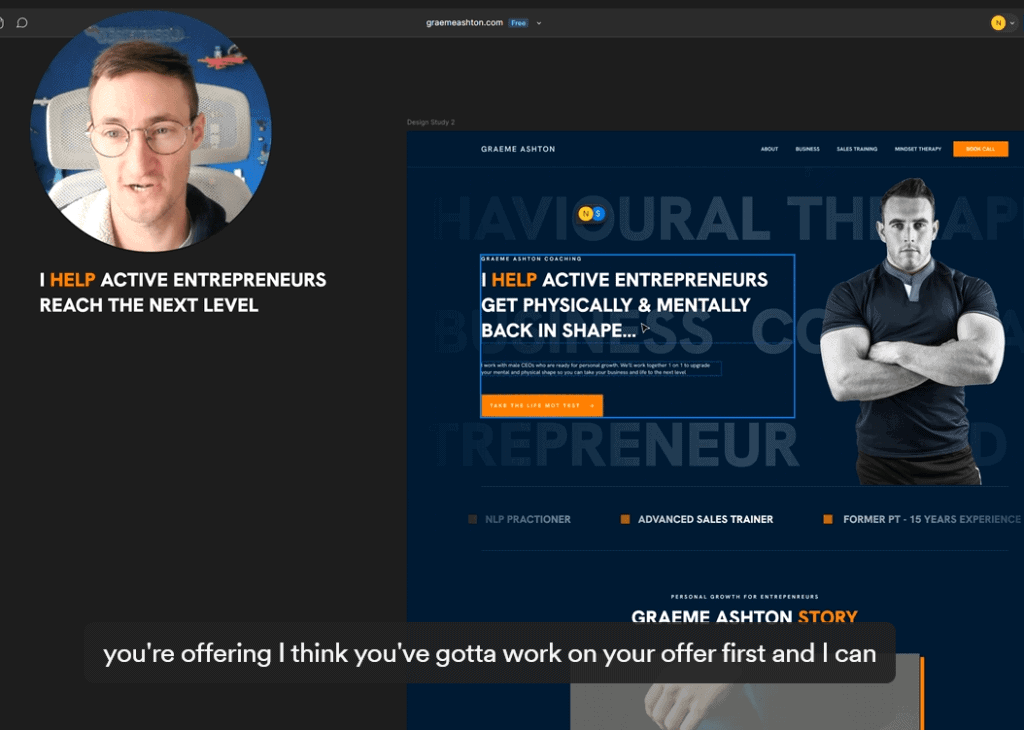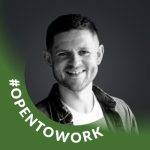I’ve just completed another brand audit for a new subscriber, and I keep covering the same basic mistake.
This year I have done over 50 brand audits for freelancers,
and I see this costs freelancers leads and money over and over again.
It stands out like a sore thumb the moment I hit the website.
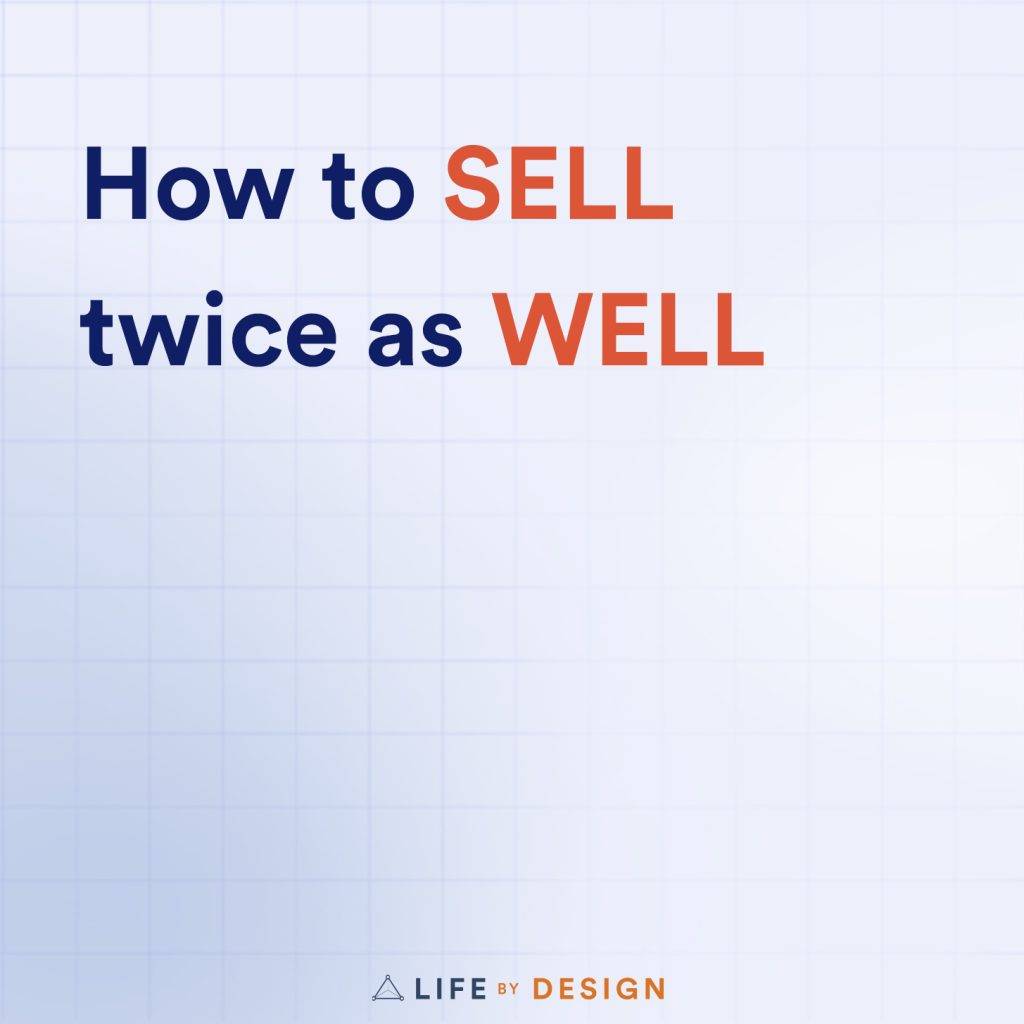


The x1 thing every freelancer seems to mess up?
A weak offer and poor messaging.
Freelancers are awful for telling people the services they offer.
They go into painful detail about their process, their skills, their years of experience.
SO WHAT?
There are thousands of freelancers out there doing the same thing, with the same process, with more years of experience,
and they are probably cheaper too.
So what is a game I play where I question every single element on the website with the question “So What?”
- so you do web design? SO WHAT?
- You have 15 years experience, SO WHAT?
- You have friendly customer service, SO WHAT?
If you want to start charging what you’re actually worth,
you need more than the same stuff everyone else has.
You need an offer that sells itself from the first second they hit the landing page, or your social profile.
You may have already heard of offers, you may be new to this concept,
I’m going to run through a framework which will help you to increase your sales and charge more for stuff you’re already doing.
In the next 10 mins we’re going to
- identify your ideal customer
- Work out what problems they most want to solve
- package your services as a solution to that problem
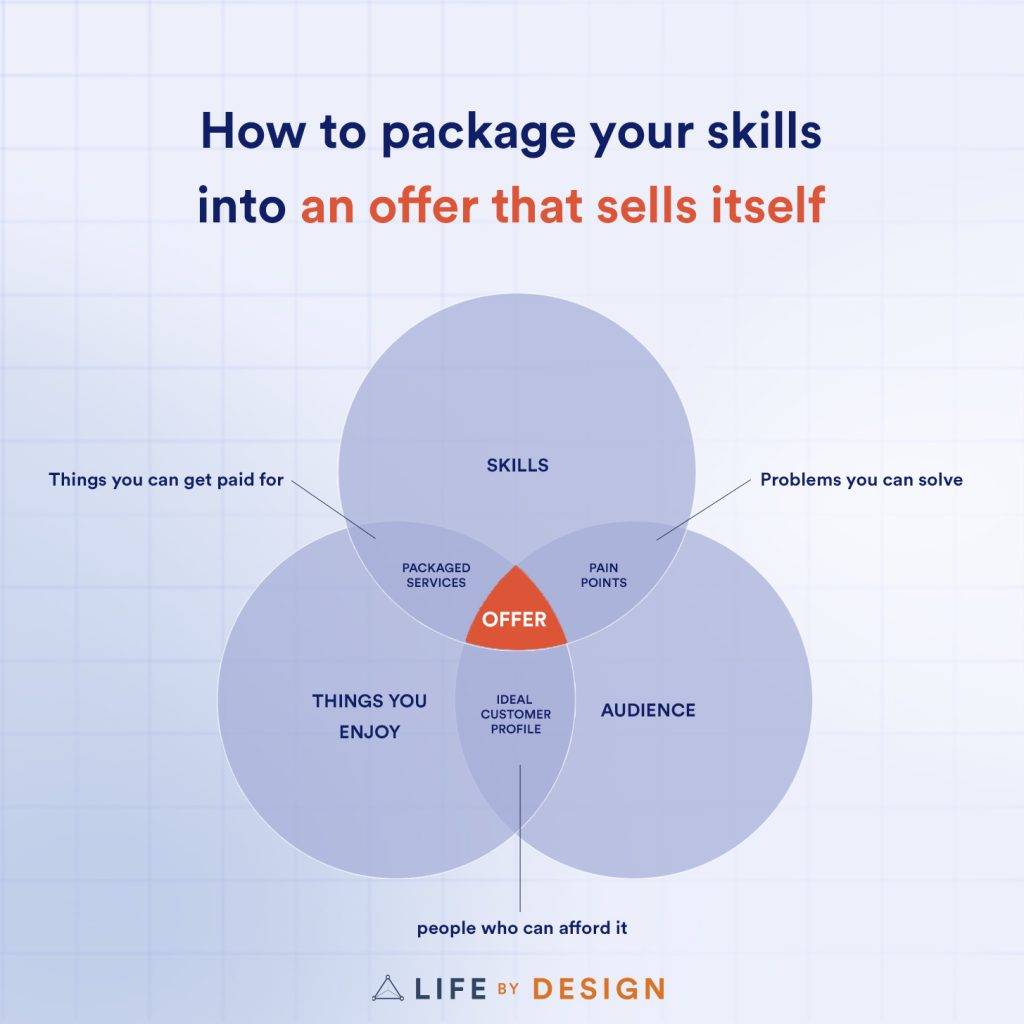
How to charge more for freelance skills and knowledge
Last week in LBD #41 we covered how to price your services.
This week we’re going to cover how to charge more.
If you aren’t earning as much as you’d like in your freelance business,
then your most important job right now is building leverage.
By leverage, I mean producing the most amount of profit with the least amount of input.
The more you earn, the less you have to work.
Leverage is what will give you more freedom, choices and control over your lifestyle.
You can take the skills you already have,
and turn it into an offer that lets you earn more, work less and live better.
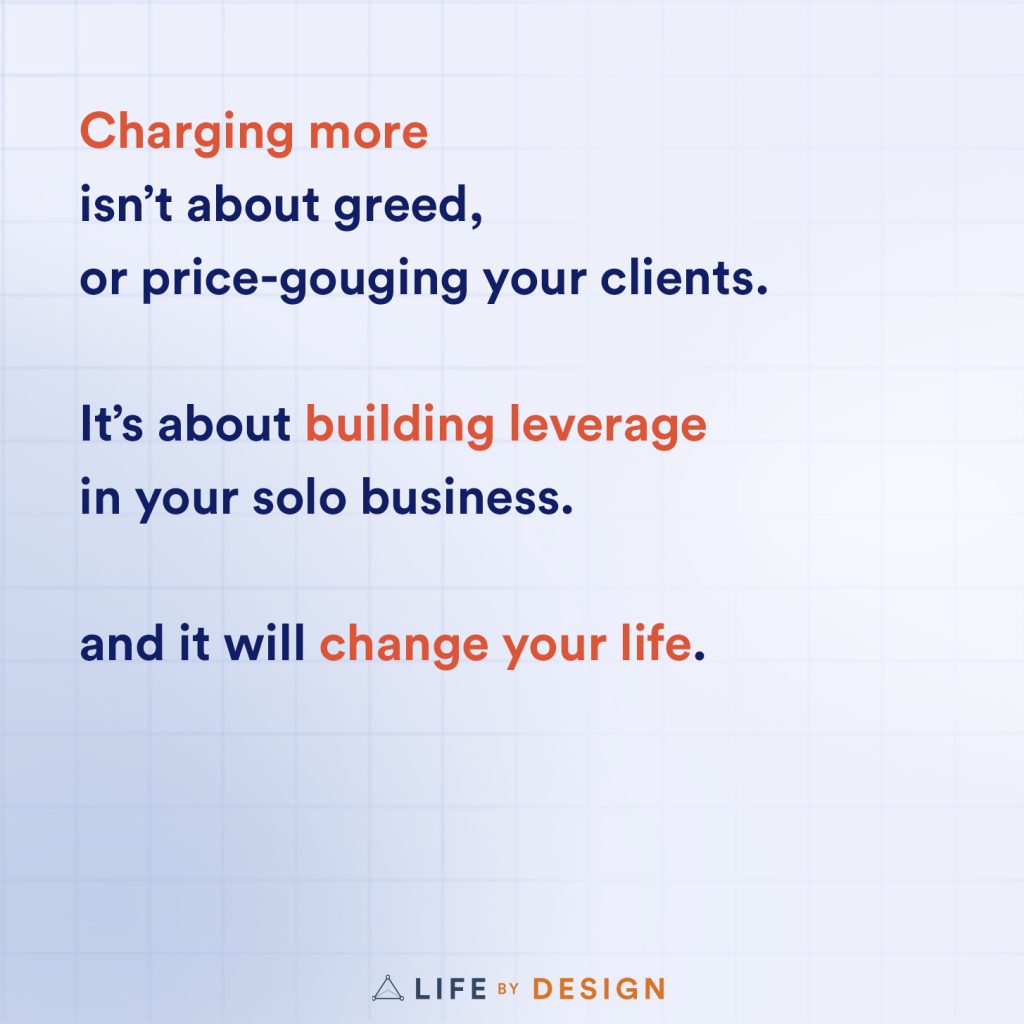
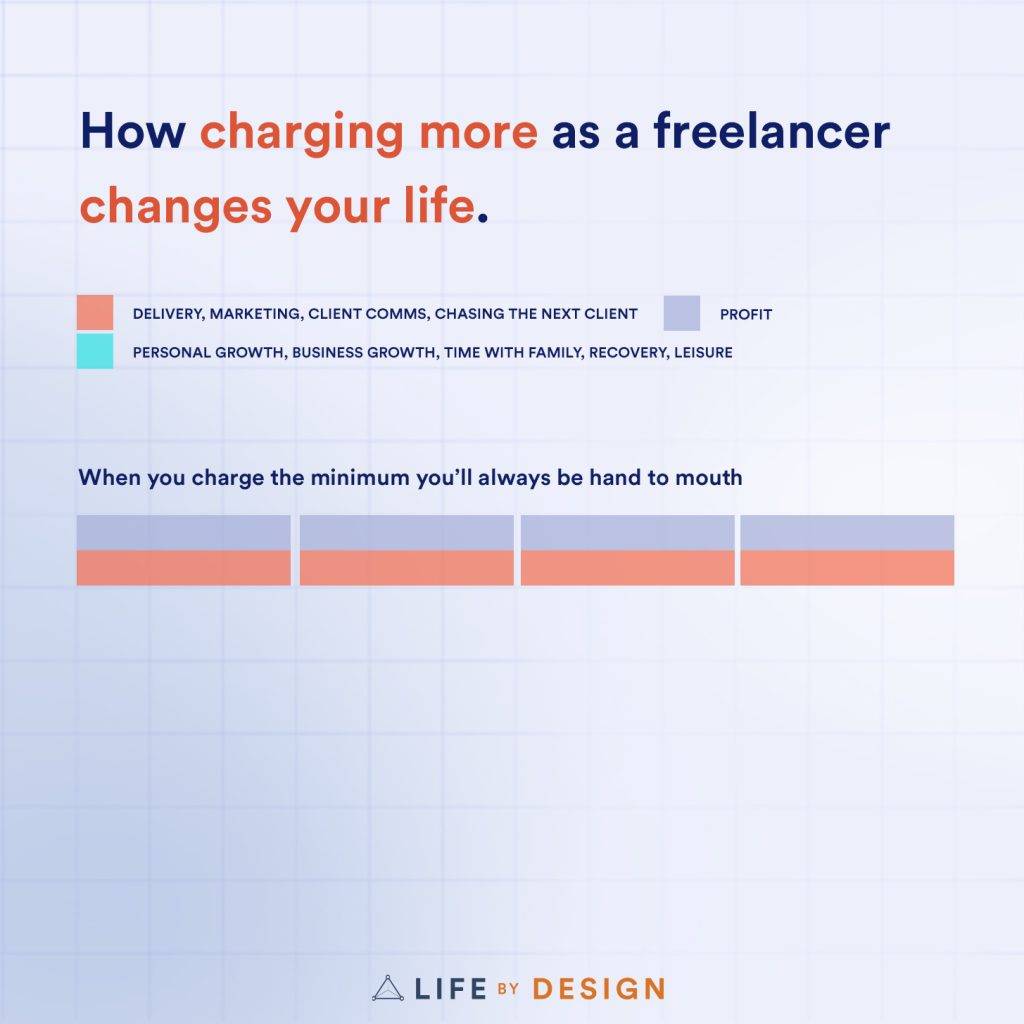
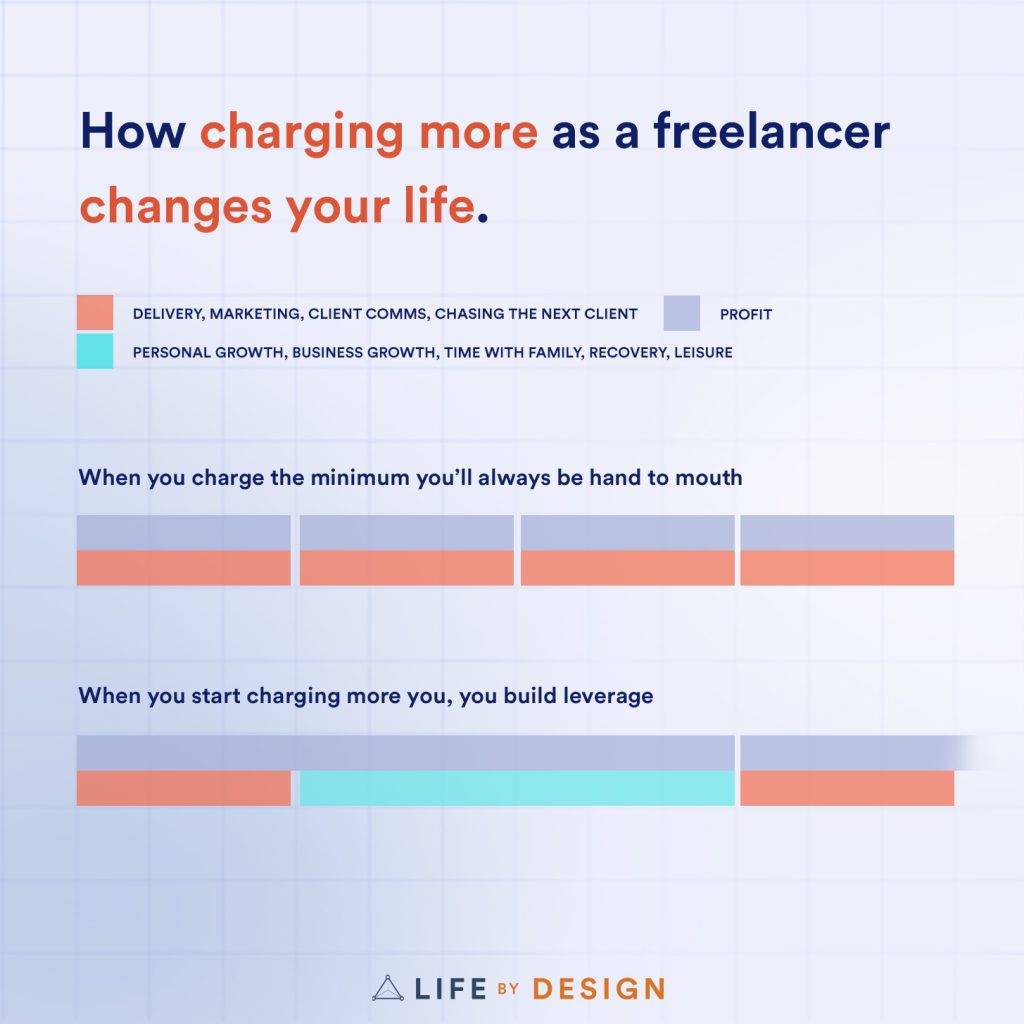

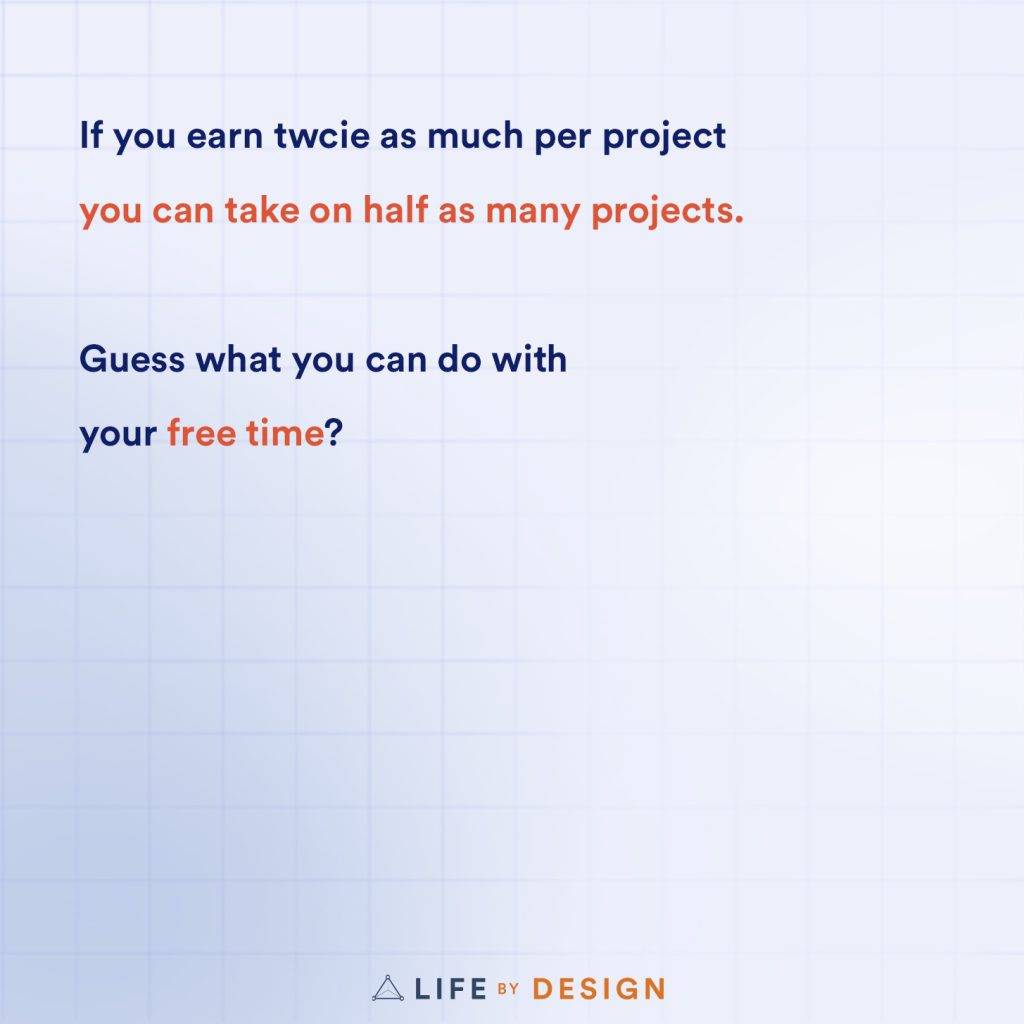
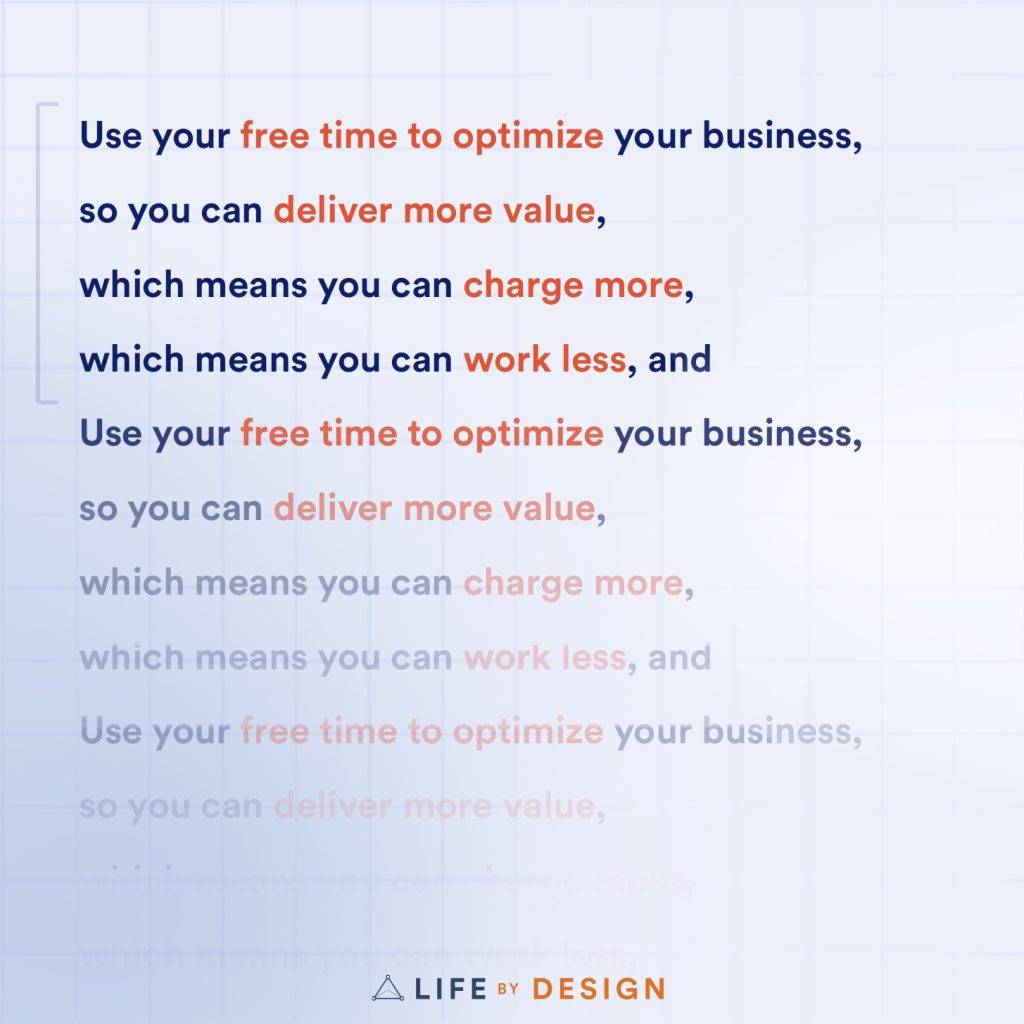
See how this works 👆
It’s a continuous feedback loop where you build leverage in your business.
But you can’t just stick a zero on the end of your price:
Everyone loves talking about raising their prices,
but no-one is talking about how or why to.
Which means the market is rampant with people overcharging while delivering poor value.
Then they wonder why they can’t close a sale,
or their clients keep leaving them.
Charging more isn’t about greed or price gouging your clients,
it’s about delivering more value, for your clients.
You do this by delivering results.
When you deliver better results you can charge more.
The result you sell is a transformation, or in other words, an offer.
Why you need an offer to charge more
There’s a lot of talk about offers,
but the premise is pretty simple:
The transformation you sell is pitched to the customer in a simple package which they can understand.
This is known as an offer.
Your offer is a short pitch that makes people want to buy from you.
Your pitch is what will set you apart from competitors,
let you charge more and make it easier to sell.
Your offer should
- identify target market
- exclude anyone else
- describe the transformation and benefits your service provides,
- pre-addreses objections to making a sale.
An irresistable offer should be…
- Dripping with value
- Targeted at ONE person
- Solve a painful problem
- Value clearly outweighs price
Examples of offers
❌ Skin treatments including fillers and peels
✅ Skin treatments for new mothers so you can feel confident in your skin
❌ Architectural services from concept to completion
✅ A fully managed architectural renovation service for passionate homemakers.
❌ Mortgage advisors with 25 years combined experience
✅ Stress-free mortgage applications for time-strapped executives.
Everything you do should be built around your offer.
There is a low income ceiling to selling skills,
because you are selling something lots of other people sell.
The key is to sell something unique to people who actually need it.
The problem is setting yourself apart from the competition.
It’s hard enough competing on a local level.
But if you sell a service which can be done remotely,
then your competition pool just expanded to the whole damn world.
With this much competition,
there’s always going to be a better designer out there.
There are plenty of designers with insane skills who make no money.
Meanwhile, I’ve seen talentless designers customizing a basic WordPress template for £5k a pop.
Why is this?
Because some freelancers are better at selling than they are at design.
And the freelancers that are good at selling are selling the transformation.
Poor freelancers are still trying to sell their services,
Rich freelancers are selling a result.
Sell the result, not the service
Think about salad in the supermarket.
A lettuce is a raw material,
a mixed salad is a result, it’s gone through a process,
it saves the customer the time and hassle of having to prepare the salad.
So let’s stop selling lettuce and start selling salad.
I’ll show you how to stack your skills into a transformation,
which combined with your brand
is a unique product that only you can sell.
If your product is unique,
you are no longer competing in price with other logo designers,
so you can charge a higher price for it.
How to build leverage in a solo business
You need to stop selling services, and start selling transformation:
- Clients don’t want a website, they want more customers.
- Clients don’t want a logo, they want to charge more.
- Clients don’t want professional photography, they want to look professional.
If you are selling logos for a fixed price,
your customers will just compare you with every other logo designer.
And if the choices are all the same,
the customer will pick the cheapest.
When you are selling the same thing as everyone else,
the only differentiator is price.
If you can’t sell for a high enough rate,
the only way to get ahead is to do more jobs, which means working more.
This is why freelancers get stuck in a race to bottom and burnout.
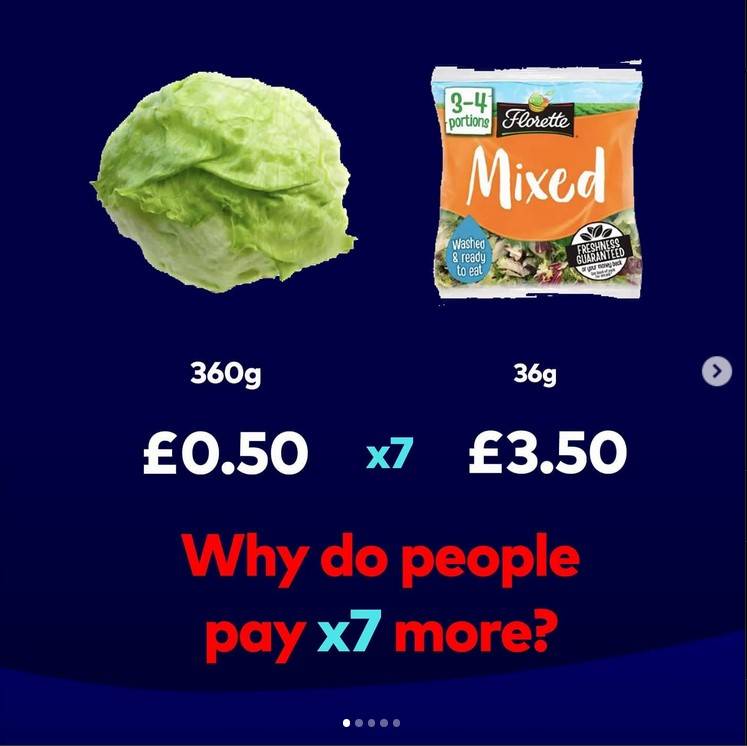
Poor freelancers are selling lettuce.
Rich freelancers are selling salad.

So start stacking your skills into results which multiple the price.
As a package they come out as MORE than the sum of their parts because you’re selling a result.
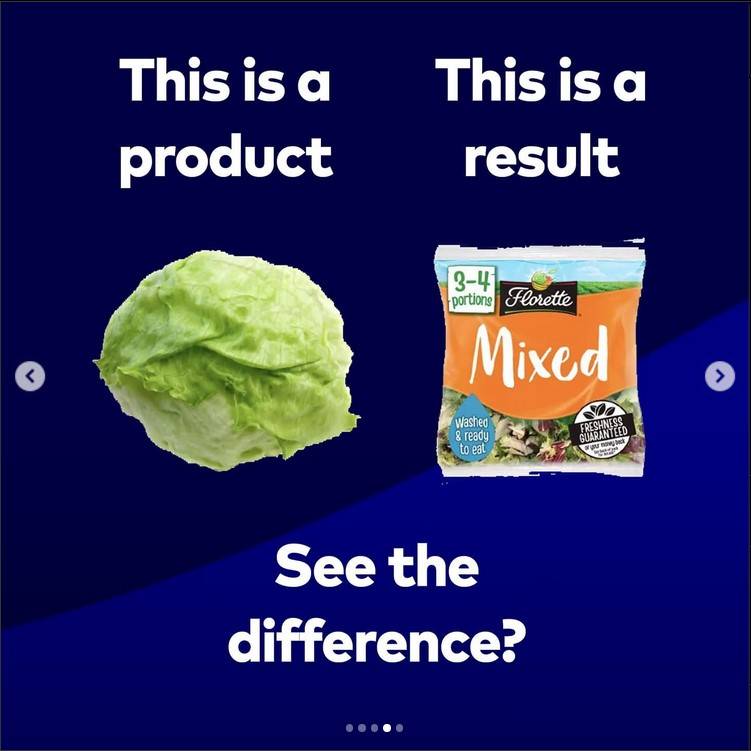
How to build an offer that sells for a one person business
There’s a lot of talk about offers,
but the premise is pretty simple:
The transformation has to be sold to the customer in a simple package which they can understand.
This is known as an offer.
- List your skills
- Identify people who your skills can help
- Identify painful problems those people have can solve with those skills
- Write down all the steps you need to do to solve that problem
- If there’s gaps in your skills or process, fill them. Don’t leave it up to the customer
- Solving this problem is what you sell now.
Your offer is a laser guided missile that hones in on one problem your customer is having and presents a solution.
Using a shotgun approach here won’t work because what has broad appeal to everyone lacks the focus that you need to make it an easy sell to someone having a really specific problem.
So an offer should always be targeted at a niche.
Niche get’s a lot of attention on social and is often misunderstood.
I found it stressful trying to figure out mine.
I jumped about a lot trying to find the “right answer”
- It helped me to realise the following:
- your niche and offer is just your current target market.
- It’s what you talk about when people ask you what you do.
- You can still sell other stuff to other people
- It can and will change, you don’t have to figure it out 100% just now, you’ll try stuff and see what works.
1 Find your skill set that sells
Almost everyone has at least x1 skill they could sell online.
If your skill is a physical skill, is there a way you can turn it into knowledge or a virtual product?
If you’re selling the same thing as everyone else, then the only thing to choose between is price, and your customers will choose the cheapest.
That’s why there are plenty of freelancers on Fiverr all selling their services for rock bottom prices.
That’s why x1 skill isn’t enough.
Write down all your skills.
Pick at least x2 overlapping or complimentary skills that complement each other and focus on getting good at them.
This is what will set you apart and give you your unique edge.
- lego + animation
- real estate + finance
- web design + SEO
- Mountain biking + video editing
- music + mixing
- motivational speaking + fitness
- cooking + wild food foraging
- construction + interior design
- woodworking + glassblowing
- Project management + networking
Stacking skills is what moves you from selling services to selling results:
- lego + animation = creator for lego brands
- real estate + finance = property buying package for high net individuals
- web design + SEO = lead generation for business owners
- Mountain biking + video editing = content generation for MTB brands
- construction + interior design = turnkey property renovation
- woodworking + glassblowing = unique high-end home furnishings
- Project management + networking = training community for project managers
2 Identify your ideal clients
You probably already have a broad customer base or audience that you serve.
Maybe you do graphic design for small business owners.
Let’s use this as an example to find a subniche within this area.
Your ideal client is are people who
- have problems your skills and knowledge can solve
- have enough money to pay for your time
- you enjoy working with
You need to get even more super specific in your target.
A handy tool I use is a customer avatar.
Imagine your audience is one person and describe everything about them.
Just an example of how specific I mean:
Extroverted male business owners aged 38,
started a brick and mortar business in the last 3 years,
struggles with having free time,
is annoyed about the new store down the street which just opened
Has x2 kids
earning 50-70k.
Your customers don’t have to fit all of the above,
This is just your ideal client to narrow your focus.
Remember the sniper rifle:
If you aim for the target, and miss by an inch, you miss the target.
If you aim for the bullseye, and you miss by an inch,
you still hit the target.
You can narrow your niche by:
- service
- industry
- demographic
- mental state
- personality
- pain points
- Local area
- gender
- age
- whatever.
3 Start speaking to your ideal customers
Identify their pain points
Once you have a few ideas of your ideal customers,
At this stage you need to do research to find the problems you can solve.
This bit takes time to figure out;
It takes a lot of thinking, chatting, reflection, failure and iteration.
A lot of time you don’t figure out what works until you try sell it,
Over time, you’ll start to hear common phrases or hooks,
that signal what people are struggling with most, and what they prioritize between price, quality, service etc.
You’re looking for those “tells” in your audience.
Start asking your ideal customers about their motivation and pain points
Some general tips
- Run polls on social media
- Ask your customers when you speak to them (“by the way…”
- Ask your newsletter if you have one.
- Notice which posts trigger the most reactions.
- Ask people in your niche about the problems
- Ask broad probing WHAT questions (“what is it about X you struggle with?”
- start broad then narrow in with WHY (“why do you struggle with that?”
- try to get to the core issues and core motivation
- what are they struggling with, why are they struggling?
- is it ego? money? clarity? etc.
- Ask your previous customers WHY they bought from you
- Ask your lost leads WHY they didn’t buy from you.
- Quality feedback in person, quantity feedback on social, polls, ask in posts etc.
- Keep a running list of these in your Notion to refer back toTry to capture the specific wording and language they use
Start broad by asking broad WHAT questions ie
What are struggling with most right now, money, time, stress?
Then move into specifics with narrow WHY questions that get to the root causes.
WHY you feel like you have no time?
Most people will be more than willing to open up and tell you if you just ask.
Put yourself in the mindset of a researcher.
Every conversation or interaction holds potential nuggets about new problems, or details on problems you’re already aware of.
You are honing your messaging each time to laser in on the language people use,
and get closer to the core of the problem.
I keep a running note of all these pain points.

4 Package your services
You can now start turning these pain points into solutions, which can be paid or free.
Example:
“My income hit a cap at 3k/m” ⇒ I sell coaching about offers
“I felt burned out after going out by myself” ⇒ I sell systems for managing burnout
“I was stuck answering emails all day” ⇒ I give away email templates and tools as a free lead magnet.
Here’s how it works:
valuable skills I can do
🔴 design
🔴 coding
🔴 IT
🔴 networking
🔴 brand design
🔴 copywriting
🔴 lead generation
🔴 email marketing
🔴 sales
🔴 finances
🔴 team building
🔴 marketing funnels
🔴 business strategy
🔴 automation
Pillars I talk about in my content
🔵 Growing startups
🔵 The benefits of a lifestyle business.
🔵 Solopreneur mindset
🔵 6 figure Business Systems
Offers I sell
🟢 Design Hero – Successfully launch a new startup in 16 weeks
🟢 Life by Design – Build a profitable lifestyle business on a 3 day workweek
This is where a lot of great designers get it backwards.
They transform themselves, learning so they can sell skills,
instead learn skills so you can sell the transformation.
5 Build an Offer means you set the price
When a client calls me to ask about a website,
They almost always start by shopping around for prices,
and they’d like to know my price.
But I’m not just a web designer.
So I’m not going to give them a price for web design:
- This always makes them pause. So I drill down:
- I ask what their goals are,
- Why they even want a website?
- what is the result they want?
Ahhhh so they want to grow their business?
well a website alone isn’t going to help with that.
They also need other things;
- They need a consistent brand strategy,
- they need copy that sells,
- they need a landing page
- and an automated lead funnel,
- then need digital marketing to drive traffic to that funnel.
So how many of their web designer has all these skills?
How many of their web designers are going to help them grow the business?
Now it’s impossible to compare my price to the other x3 prices,
because it’s not the same thing.
They’re going to have to find, and pay, another 3 or 5 people at least to get to the result they want.
I haven’t even told them my price yet.
So then I explain how my process works,
How it gets them to the result they want,
and skips all the other people and services along the way,
and works out cheaper than hiring x6 different people all of whom have to be checked and vetted.
So now I pitch them my offer.
I’ll provide everything you need to launch this new business successfully in the next 12 weeks, plus ongoing mentoring to keep you on track and fill any gaps in your knowledge.
Vs
I’ll design a website, the rest is up to you.
Your offer is a pitch which defines the transformation, what you do, how you help them, and addresses any objections, all in a few short sentences.
A good offer sells itself, so you don’t need to be the pushy salesman on a salescall.
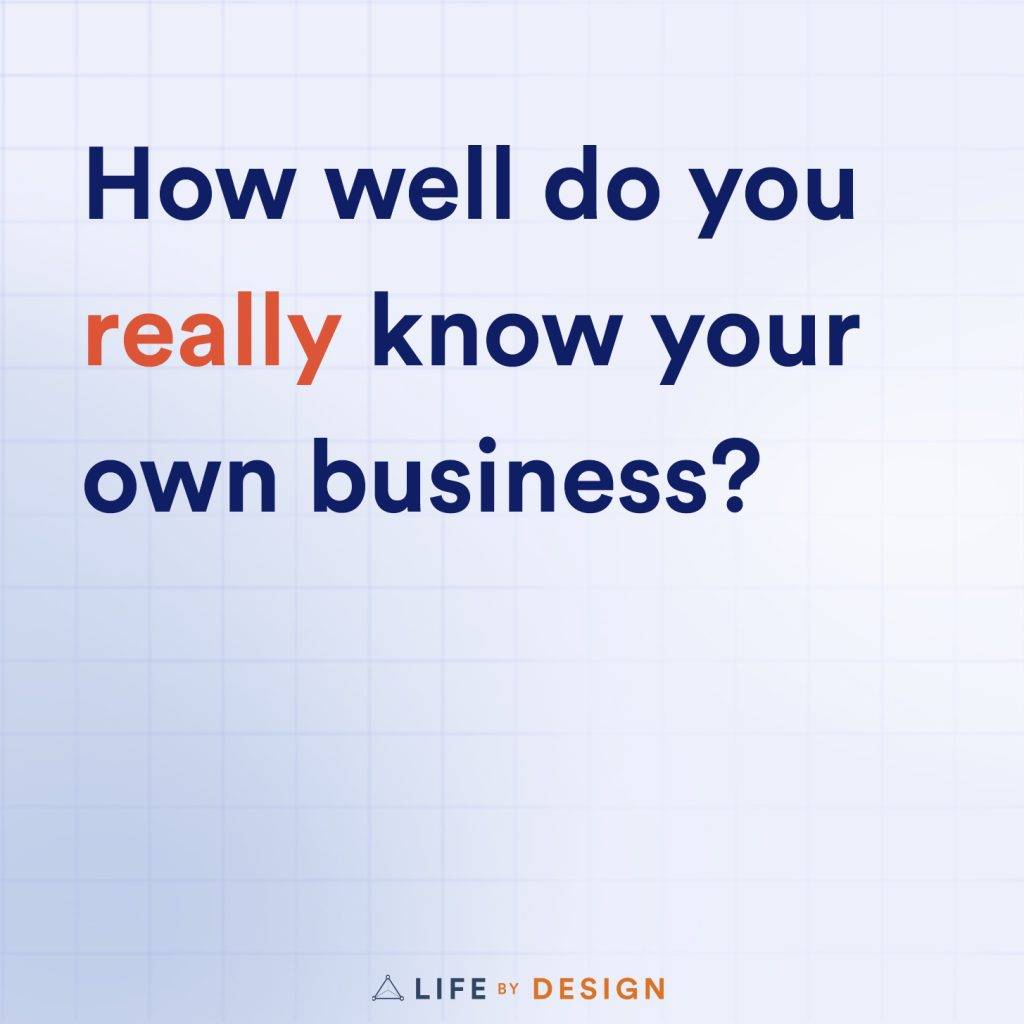
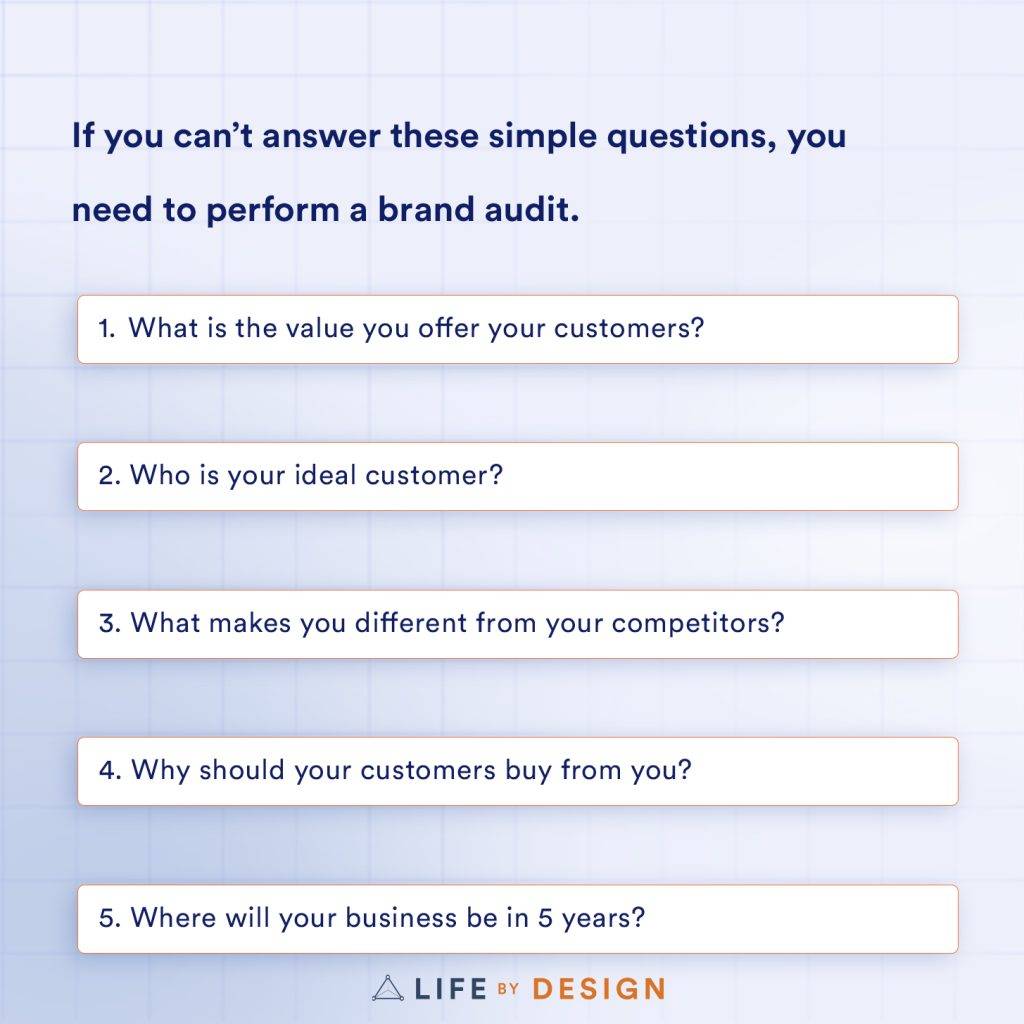
If you’re struggling with all of this,
I teach a series of systems in Phase 2 of my core coaching programme Systemized Solopreneur to help you build a safety net of profit for your freelance business.
- Identify your ideal customer
- craft a killer offer
- build a pitch is easy to sell
- optimize your profile and brand around your offer
- An inbound leads system to attract your ideal customers
- an outbound system to contact your ideal customers
- a lead magnet to help you demonstrate your value and draw people into your brand
- sales coaching to help you sell more successfully and for higher rates
You can grab 1-1 help from me on this if you wish.
Or if you prefer to do it yourself,
I have a workshop where you can build yourself a killer offer, with templates examples a video walkthrough
you can grab my offer worksheet here
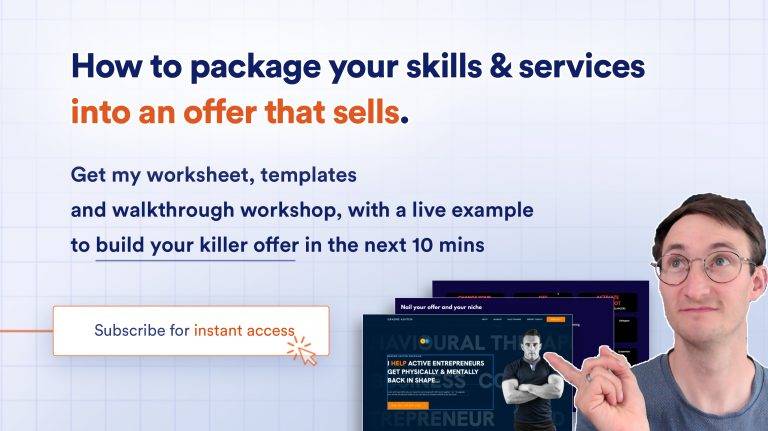
Want to start charging more for your services?
Subscribe for instant access to my guided offer workshop with templates and examples.
If you want some 1-1 help with this…
I often perform freelance audits as part of my freelancer coaching, during phase 2 where we build a 6 month safety net of profit in your business/
I also gift audits as an incentive for new subscribers to gather information about my audience.
After joining Life by Design, as soon as someone fills out the 30 second welcome survey,
I perform a 5-10min audit where I record myself going through
- Website design
- Landing page conversion
- Brand consistency
- Services and offering
- Copywriting and messaging
- Social profits
- Digital products
- Marketing funnels
- Anything else I can find on them.
I immediately drop practical, actionable advice about how they can get more leads, charge more, convert more customers, attract more customers.
It’s a pretty good bribe value exchange for 30 seconds of their time, if you’re curious you can sign up and fill out the survey.
Plug over. anyway…
